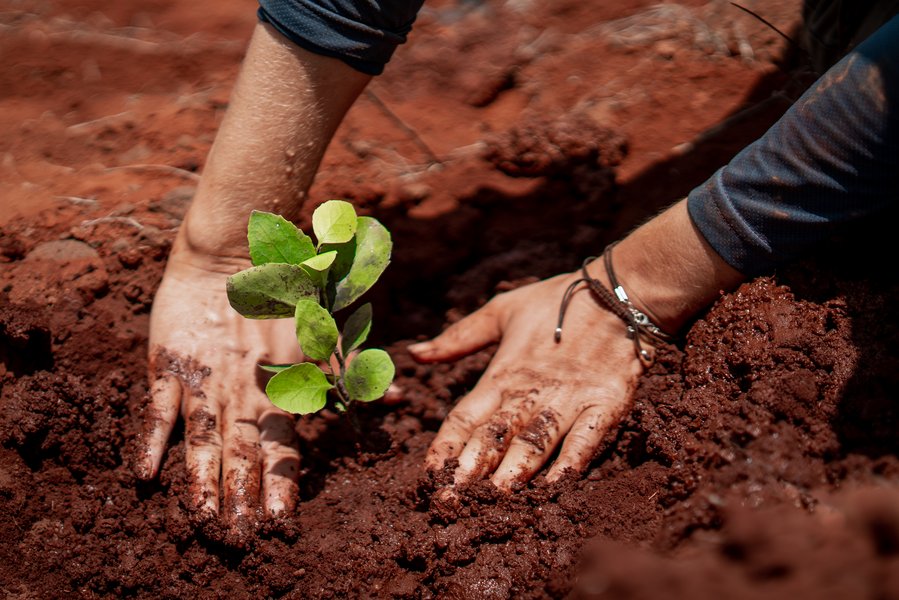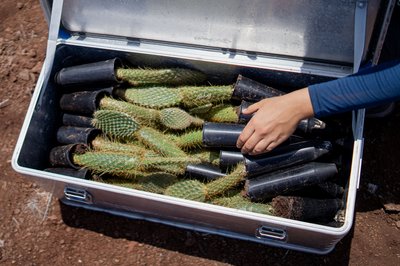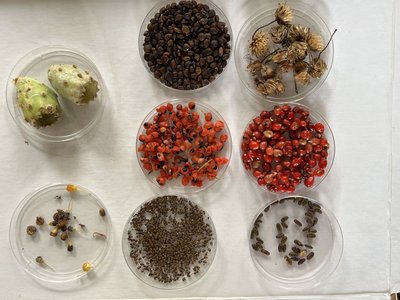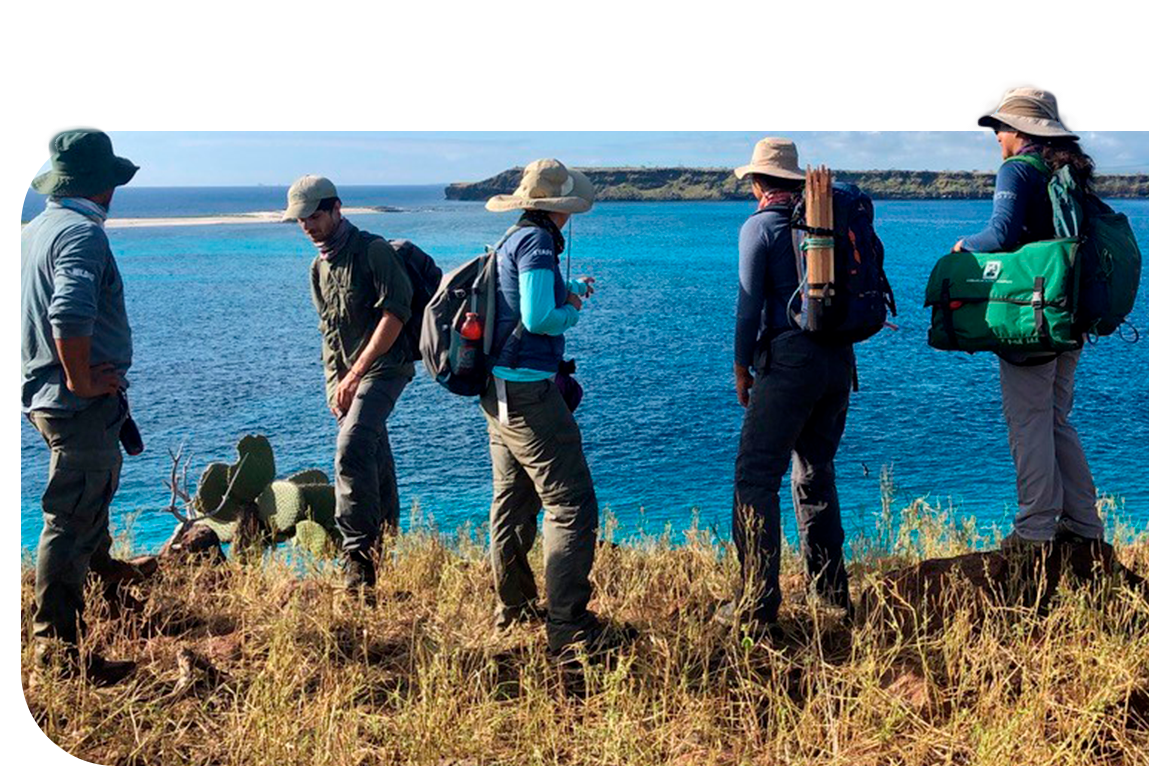In Galapagos, 83% of the landmass falls within the arid zone. Restoring plant communities in this zone is challenging and slow, and natural regeneration in severely degraded areas is very limiting. Our scientists work to restore the arid habitat across various islands in the archipelago, notably Baltra Island, which has undergone significant human alteration, and special use sites such as garbage dumps and quarries on inhabited islands.

Our team
Patricia Jaramillo Díaz
Principal Investigator - Galapagos Verde 2050
Paúl Mayorga
Technical Assistant
Danyer Zambrano
Field Assistant
Other Collaborators
Alan Tye, UICN
Alberto Vélez, Carlos Efraín Masaquiza Chango, Jean Pierre Cadena, Ronal Azuero. Agencia de Regulación y control de la Bioseguridad y Cuarentena para Galápagos (ABG).
Antonio León-Reyes, Universidad San Francisco de Quito
Bettina Meier, PhD. Bioinformatics and Statistical Analysis. UK.
Christian Smit, Rijksuniversiteit Groningen
Diego Ellis-Soto, PhD. University of California, Berkeley
Jéssica Duchicela Escobar, Universidad de las Fuerzas Armadas – ESPE
José Cerca, PhD. Swedish Museum of Natural History
Michael D. Martin, PhD. Norwegian University of Science and Technology (NTNU)
María del Mar Trigo, Universidad de Málaga
Nicolás Velasco, Universidad de Las Américas y Universidad de Chile
Ramiro Osciel Bustamante Araya, Universidad de Chile
Tui De Roy, Fotógrafa de vida silvestre y naturaleza.
Vanessa Bieker, José Cerca, Mike Martin. Norwegian University of Science and Technology (NTN).
Washington Tapia, Species Survival Commission (SSC) of the IUCN
Collaborating Institutions
Galapagos National Park Directorate
Agencia de Bioseguridad Galápagos
Ciencia Pura
Galapagos Conservancy
Lindblad Expeditions National Geographic Fund
Norwegian University of Science and Technology (NTNU)
Universidad de Alicante
Universidad de Chile
Universidad de Málaga
University of Groningen
Universidad de las Fuerzas Armadas-ESPE
Universidad Estatal de Nueva York
University of Copenhagen
Donors
COmON Foundation
Stanley Smith Horticultural Trust
Hurtigruten Foundation
Association “Friends of the Galapagos Islands” Switzerland
Galapagos Conservation Trust
Johnsonswax del Ecuador S.A.
The challenge
Achieving restoration success in the arid zone is difficult. Growth and survival of plants is impeded by limited rainfall and unpredictable variability in its occurrence, and the impact of decades of introduced herbivores which have significantly altered plant abundance and composition. While plant species in arid zones have evolved over millennia to withstand drought and scarcity of rainfall, they now face additional challenges from increasingly extreme weather patterns due to climate change. For example, even if natural regeneration of plants occurs during the rainy season, the dry season can be so harsh that all seedlings die, leaving the plant community with little to no possibility of recovery.
Part of the challenge for successful restoration processes is the high cost associated with providing water to critically threatened species in isolated locations affected by drought. Additionally, this labor-intensive and time-consuming initiative requires a well-structured and adequately funded long-term restoration plan.
The Charles Darwin Foundation, through its Galapagos Verde 2050 (GV2050) team of restoration professionals, aims to address these complexities to restore degraded drylands in the Galapagos, and find more cost-effective ways to safeguard the islands' arid zone biodiversity.
Why it matters
Restoring arid zone vegetation in Galapagos is crucial for preserving the structure, function, and health of these fragile ecosystems. Animals such as land iguanas, finches, and mockingbirds rely on this plant community for their own survival. Additionally a host of other less visible but important species call this habitat home.
What we do
Our work focuses on restoring vegetation on degraded remote islands in arid zones, as well as special use sites in Baltra, San Cristóbal, and Floreana islands.
Planting and monitoring
We assess the best methods to increase the growth and survival of several native and endemic plant species inhabiting arid zones of the Galapagos. We use restoration tools such as water-saving technologies or Biochar to test which combination of these tools are the most cost-effective for each individual target species.
Using reference ecosystems
To restore heavily degraded Baltra Island, we use reference ecosystem models. This approach involves studying the composition, structure and abundance of plant species on neighboring ecosystems such as North Seymour island. By using North Seymour as a "proxy" ecosystem, we can establish clear restoration targets and expected outcomes for Baltra.
Establishing nucleated restoration
We are recreating ecological patches of regeneration on Baltra Island in an effort to increase connectivity, thereby assisting regeneration in nuclei and connecting the landscape through animal plant-dispersal.
Evaluating restoration efforts at special use sites
The assessment of restoration efforts at special use sites such as garbage dumps and quarries that we have conducted for over a decade, show positive results not only in terms of improved vegetation coverage, but also in terms of higher biodiversity values. Continuing these actions at restoration sites would allow natural processes to recover and mutually reinforce healthy ecological dynamics. These dynamics will then serve as a baseline to inform future restoration actions.

Program Objectives
By using innovative methodologies and technologies such as Hydrogel and Biochar, the GV2050 initiative is working to overcome challenges such as limited water supply and unpredictable climate patterns and thereby enhance native endangered plant survival and ecosystem recovery.
- Evaluate and compare biodiversity in degraded areas to guide restoration efforts.
- Use native Galapagos plants for ecological restoration of degraded habitat.
- Enhance ecological connectivity between natural and degraded areas to restore ecosystem function and native wildlife.
- Implement adaptive management in restoration programs to address climate change.
- Promote restoration initiatives through community engagement campaigns.
About GV 2050
The GV2050 program has a multidisciplinary research team that brings together professionals, including ecologists, conservation biologists, biotechnologists, botanical taxonomists, and environmental engineers. We have worked with the Galapagos National Park Directorate for more than a decade, leveraging both institutions' scientific expertise and practical knowledge. This fosters a comprehensive approach that aligns scientific guidance with effective on-the-ground restoration efforts.
Our impact
Restoring gravel mines
- Within a four-year period, the arid vegetation of Floreana's gravel mine has been restored to a condition comparable to nearby non-degraded sites.
- At the Cerro Colorado gravel mine on San Cristobal Island, we have successfully restored 53 individuals of the critically endangered Calandrinia galapagosa and 79 individuals of the threatened Lecocarpus darwinii. This represents 85% and 83% of the restored populations of these species, respectively, both of which are at risk of extinction.
Restoring garbage dumps
Since 2015, restoration efforts have been underway at two former garbage dumps. At the Floreana garbage dump, 516 plants have been planted since 2015 and at Baltra's old garbage dump, over 1,500 plants have been planted since 2016. At both sites, the majority of the plants have grown, reaching sizes that ensure the successful recovery and future sustainability of these areas.
Restoring Baltra Island
Our restoration efforts on Baltra have yielded significant impacts since our first actions:
- Over 8,100 plants of 12 different species have been planted since 2014.
- Studies of plant communities have deepened our understanding of ecosystem interactions, expanding the selection of species for restoration from 12 to 15.
- 4,200 seeds of seven priority species have been collected for ex situ germination prior to reintroduction into degraded areas.
- Trials of innovative technologies such as Waterboxx, Cocoon, and Hydrogel have been underway since 2014, yielding higher survival of plants.
- Research data from these trials informs the most cost-effective combination of species to outplant and technologies to scale-up restoration.


Why you should support us
In the Galapagos Islands, arid habitats face significant challenges, including limited rainfall and the impact of climate change, which threaten the survival of native plants and the animals that rely on them. Our restoration efforts are critical to maintaining ecosystem health. We utilize innovative, cost-effective methods to enhance plant growth and survival, essential for supporting biodiversity and ecological function.
Your donations help ensure that these important conservation efforts continue, preserving the unique and fragile ecosystems of the Galapagos for future generations.

Resources
Libro “Siémbrame en tu jardin”
Atkinson, R., Guézou, A., & Jaramillo, P. (2009). Siémbrame en tu jardín-Plantas nativas para jardines en Galápagos. Puerto Ayora, Galápagos: Charles Darwin Foundation.
Libro “Galapagos Verde 2050 (Volumen 1)”
Jaramillo, P., Tapia, W., Negoita, L., Plunkett, E., Guerrero, M., Mayorga, P., & Gibbs, J. P. (2020). The Galapagos Verde 2050 Project (Volume 1). In P. Paramillo, W. Tapia, & J. P. Gibbs (Eds.), 67.
Guía de semillas y propágulos de Galápagos
Jaramillo, P., Shepherd, J. D., & Heleno, R. (2021). Guide to Galapagos Seeds and Propagules. Puerto Ayora-Isla Santa Cruz: Charles Darwin Foundation.
Artículo científico sobre la efectividad de las tecnologías ahorradoras de agua
Tapia, P. I., Negoita, L., Gibbs, J. P., & Jaramillo, P. (2019). Effectiveness of water-saving technologies during early stages of restoration of endemic Opuntia cacti in the Galápagos Islands, Ecuador. PeerJ, 7, e8156.
Artículo científico sobre la costo-efectividad de las tecnologías ahorradoras de agua
Negoita, L., Gibbs, J. P., & Jaramillo Díaz, P. (2022). Cost‐effectiveness of water‐saving technologies for restoration of tropical dry forest: a case study from the Galapagos Islands, Ecuador. Restoration ecology, 30(5), e13576.
Artículo científico sobre restauración de Scalesia affinis
Plunkett, E., Negoita, L., Sevilla, C., Velasco, N., & Jaramillo, P. (2023). Enhancing restoration success of rare plants in an arid-tropical climate through water-saving technologies: a case study of Scalesia affinis ssp. brachyloba in the Galapagos Islands. PeerJ, 11, e16367.
Cevallos, D., & Jaramillo, P. (2024). Assessing Water-Saving Technologies and the Impact of Giant Tortoise Herbivory on the Restoration of Opuntia megasperma var. orientalis on Española Island - Galapagos. Water (Switzerland) MDPI, 16(3–369), 12.
Discover How the Galapagos Islands' Ecosystems Guide Ecological Restoration
Velasco, N., Calle-Loor, A. and Jaramillo, P. (2024) “Defining large-scale arid island vegetation recovery targets through evaluating a reference system within an archipelago extent,” Restoration Ecology. 1-12.

Protect Galapagos, Impact the World
The impact you make on this small ecosystem of enormous biodiversity is part of a larger footprint you are leaving for the world's future. Join us on our mission to safeguard one of our planet’s most important natural treasures through science and conservation action by making a donation today. Thank you for making an impact with us.







